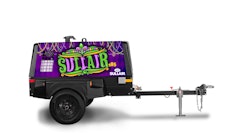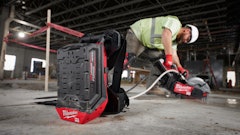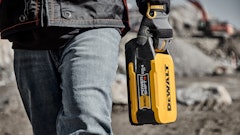
The expression “more power to you” is not usually meant in the literal sense but rather to encourage someone or show approval of their actions.
However, in this case, it's meant in the literal sense.
Generator and compressor manufacturers explain how rental companies—and their end customers—can get the most out of their power-generating equipment.
Size It Up
When helping customers decide on a compressor, rental companies should ask as many questions as possible to find out what application the equipment is being used for, what kind of work the customer is doing, what type of tools they’re using, the number of tools they’re using, etc., according to Chance Chartters, sales manager, Mobilair portable air compressors, Kaeser.
“You want to find out the items about the job or the application that will be helpful in making sure they get the right size compressor for their job,” Chartters says. “The best thing is to know who their customers are and what their typical customers rent when they come in to rent a compressor and what they're using it for. The rental house should know what tools they're running along with the air compressor and what flows are required for the tools they rent.”
Rental companies should ask a similar series of questions of their customers when they come in to rent a generator.
“The most common way to get an accurate sizing is to list all the equipment that you really want to power and the energy requirement for each piece of equipment, and then size your generator in accordance with that,” says Tim Doling, global director of innovation and development at POWR2.
However, he notes that there are certain variables that are difficult to predict.
“You may have a whole list of equipment, but you don’t know if it’s all going to be turned on at the same time or what equipment is going to be used when, so you really have to size it based on the worst-case scenario, which is to say that first thing in the morning, crews get to the jobsite, and they switch everything on all at once,” Doling says. “There’s going to be a massive spike in demand, and you have to size the generator based on that spike in demand.”
If generators are not sized appropriately, they will not run efficiently, leading to service issues.
“When a generator is not running at its required load, it's building up carbon particles on the exhaust, called wet stacking,” Doling says. “This can eventually lead to the generator actually failing. It’s more a service issue, but then there's also the environmental fact that the generator is running inefficiently, and unless you put an artificial load on it to make it run at its peak efficiency, you're actually just wasting energy there.”
Recent Trends
To help contend with load and sizing issues, battery energy storage systems have come on the scene to create hybrid solutions.
“By putting a battery or an energy storage system in line with the generator, you only use the actual energy that's required by the load, so generators can be switched off for long periods of time,” Doling says. “We just provide the power needed for that item, and then when the battery is depleted, we call for the generator to come on. So, we run the generator for a short period of time at peak efficiency rate and switch it back off again.”
In other words, Doling says that generators that are running 24 hours a day inefficiently could be running as little as three to four hours a day efficiently.
“The batteries can help smooth out the peaks and troughs and load, so the generator just runs when the peaks are required, and the battery can take up the periods of low load,” Doling says.
The battery systems typically consist of three basic components: batteries, inverters to convert the energy between Dc and Ac output into a usable form and a control system, according to Aaron LaCroix, product manager at Generac.
LaCroix adds that the battery energy storage system is going to be connected to some type of charging source in the case of mobile power such as a diesel generator.
“Generators by themselves have the advantage of a long run time when they have a full tank of fuel, so depending on the load, you could run for days at a time, but with the battery energy storage system, you can easily power both low loads and variable loads while emitting zero sound and zero emissions,” LaCroix says. “Working together, they’re designed to run at optimum efficiency, so combining these technologies allows for even longer run times.”
LaCroix adds that other benefits include a reduction in both fuel consumption and maintenance costs.
“In the mobile air industry, we’ve really seen a shift to more sustainable solutions and reducing greenhouse gas emissions,” LaCroix says. “This technology can make a significant impact on companies that have targets to reduce their emissions.”
Hydrogen generators also make up a portion of the new technology in the generator space.
“It’s very clean burning and plentiful, but there are some challenges about how to transport it and safely bring it to jobsites,” Doling says. “However, the desire for clean solutions means that hydrogen is being looked at seriously, in addition to other gaseous fuels.”
What to Keep in Mind
As with any piece of equipment, rental companies should ensure everything is operating properly on generators and air compressors before renting them out.
For compressors, rental houses should also check the hoses attached.
“It’s called a whip check, and it is a little cable that goes between the connection of the air compressor and on the hose itself,” Chartters says. “So, if for some reason, the hose does become uncoupled with the air compressor, it keeps it from whipping around. When you connect it to the air compressor, there's a safety pin that keeps the claw coupling from coming out as well. So, make sure those safety pins are used.”
When it comes to battery-powered equipment, rental customers should reiterate to their customers that battery solutions produce power silently.
“Because they have years of experience running diesel generators and other engine-powered equipment, they are used to something making noise when it’s producing power,” Doling says. “We have to reinforce that all the time because it could be a potential safety risk if someone is not aware the equipment is running.”






























